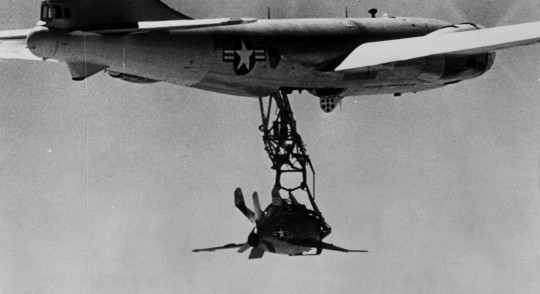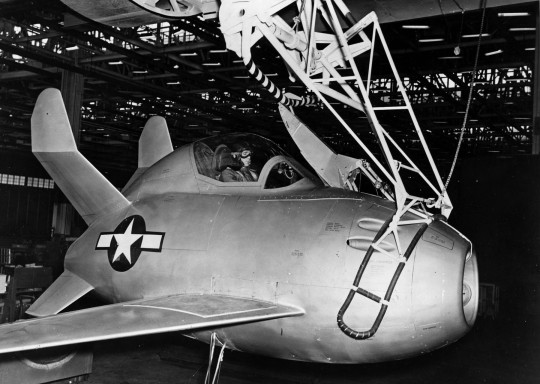#XF-85 prototype
Explore tagged Tumblr posts
Link
The article by Peter Suciu on "The Armory Life" discusses the McDonnell XF-85 Goblin, a prototype "parasite" fighter jet developed during the Cold War by the U.S. Air Force. Intended to provide protection for bombers beyond the range of conventional escorts, it was designed to deploy from bombers mid-flight, such as the Convair B-36 Peacemaker and initially tested with a Boeing B-29 Superfortress. The Goblin's design included innovative features like foldable wings and a trapeze deployment system, but the project faced critical challenges, including difficulty in recovery due to turbulent air and limited flight endurance. Only two prototypes were built before the program was canceled, and the article explores the project's historical context, its technological ambitions, and subsequent efforts in developing parasite fighters, emphasizing the rapid advancement of Soviet fighter technologies and the transition to more promising aerial refueling techniques. The article also reflects on the legacy of the XF-85 Goblin and the potential future of unmanned collaborative combat aircraft concepts.
#McDonnell XF-85 Goblin#parasite fighter#B-36 bomber#Convair B-36 Peacemaker#McDonnell Aircraft Corporation#Frank Everest#Bell X-1#ejection seat#air defense#Cold War#U.S. Air Force#1948#aerodynamic design#retractable fuselage#wingtip tanks#flight testing#XF-85 prototype#rocket engine#airspeed#performance#manned interception.
0 notes
Text
McDonnell XF-85 Goblin



The McDonnell XF-85 Goblin is an American prototype fighter aircraft conceived during World War II. It was intended to deploy from the bomb bay of the Convair B-36 bomber as a parasite fighter. The XF-85’s intended role was to defend bombers from hostile interceptor aircraft. McDonnell built two prototypes before the USAAF terminated the program.
More photos here.
#XF85Goblin#F85Goblin#Aviation#aeroplane#airplane#aircraft#fighter#jetfighter#fighterjet#USAF#ColdWar#McDonnellXF85Goblin
2 notes
·
View notes
Video
XF-85 Goblin - McDonnell Parasite Fighter Aircraft - The Ultimate Guide ...
#youtube#parasite#experimental#airplane#aircraft#weird#weirdwings#military#us air force#ultimate guide#prototype#xf85#goblin#xf-85#xf-85 goblin#mcdonnell#fighter aircraft
2 notes
·
View notes
Text

"The Smallest Fighter" by Mark Karvon, link.
"From the time the bomber was used in warfare, there was a need to protect the aircraft from enemy fighters. Fighters generally lack the long range of a strategic bomber which meant bombers had no fighter protection when their escorts had to turn back. After WWII, one idea was for the bombers to carry their own escorts. From this concept the XF-85 Goblin was born.
The XF-85 Goblin was a prototype jet fighter designed to be carried within the bomb bay of a B-36 Peacemaker bomber. In operation, the diminutive fighter would be released when enemy fighters were encountered. After protecting the formation, the Goblin would rendezvous with the bomber for retrieval.
In testing the XF-85 flew quite well. It had an estimated top speed of 648 MPH, it was maneuverable, stable, easy to fly and recoverable from spins. problems arose when trying to retrieve the fighter. It was meant to hook up to a trapeze extended beneath the bomber. Turbulence beneath the bomber created difficulties. At one point the fighter collided with the trapeze shattering the canopy and requiring an emergency landing. There were seven flight tests in all with only three of them resulting in successful hook-ups.
Despite its good flight qualities, the Goblin was still considered deficient when compared with contemporary jet fighters of the day. In-flight refueling practices were also being perfected which solved the problem of short range fighter aircraft. The program was cancelled. Both XF-85 Goblins survive in museums. The aircraft is the smallest jet powered fighter ever produced."
#McDonnell XF-85 Goblin#XF-85 Goblin#McDonnell XF-85#XF-85#F-85#Fighter#United States Air Force#U.S. Air Force#US Air Force#USAF#artwork#my post
134 notes
·
View notes
Photo

McDonnell XF-85 Goblin is an American prototype fighter aircraft conceived during World War II by McDonnell Aircraft. It was intended to deploy from the bomb bay of the giant Convair B-36 bomber as a parasite fighter.
29 notes
·
View notes
Video
instagram
A very close call and a great save! First flown in 1948, the McDonnell XF-85 Goblin was a prototype parasitic fighter that was intended to be deployed from B-36 bomber. However, during testing a converted EB-29B Superfortress was used as seen here. The test pilot on the project was Edwin Foresman Schoch. As the Goblin was extremely sensitive to the bomber's turbulence, constant but gentle adjustments of throttle and trim were necessary. On his 4th attempt at docking with the EB-29, Schoch miscalculated his approach and struck the trapeze so violently that the canopy was smashed and ripped free and his helmet and mask were torn off. He saved the prototype by making a belly landing on the reinforced skid at the dry lake bed at Muroc. Two Goblins were built flying a total of seven times, with a total flight time of 2 hours and 19 minutes and only three of the flights ending in a successful hookup. Prior to becoming a test pilot, Schoch was a naval aviator during WWII flying F6F Hellcats, and F4U-4 Corsairs ending the war with 4 kills. Schoch was tragically killed on his 35th birthday while making a test flight to investigate elevator-related issues on a F2H-2 Banshee. Metal fatigue caused the tail section to fail, and the aircraft came apart in the air. He was killed in the ensuing crash. 🌎www.iloveahangar.com 📷Feel free to repost but please remember to tag us 👍😊 #aircraft #airforce #airshow #avgeek #aviation #aviationdaily #aviationgeek #aviationhistory #aviationlovers #aviationphotos #avnerd #militaryaviation #militaryaviationphotography #oldairplanes #navalaviator #planepics #navalaviation #fighterpilot #warbird #warbirds https://www.instagram.com/p/CQdsPAfloFP/?utm_medium=tumblr
#aircraft#airforce#airshow#avgeek#aviation#aviationdaily#aviationgeek#aviationhistory#aviationlovers#aviationphotos#avnerd#militaryaviation#militaryaviationphotography#oldairplanes#navalaviator#planepics#navalaviation#fighterpilot#warbird#warbirds
4 notes
·
View notes
Text


The XF-85 Goblin prototype at the National USAF Museum, July 2020
Quite the interesting bird, a shame it was an evolutionary dead end
35 notes
·
View notes
Video
McDonnell XF-85 Goblin at Wright-Patterson by Johnny Comstedt Via Flickr: Marked USAF 46-0523. First of two prototypes of a "parasite" fighter to protect B-36 bombers flying far beyond the range of conventional escort fighters. The "parent" B-36 would carry the XF-85 within a bomb bay -- if enemy fighters appeared, the Goblin would be lowered on a trapeze and released to combat the attackers. Once the enemy had been driven away, the Goblin would return to the B-36, reattach to the trapeze, and be lifted back into the bomb bay. The program ended in 1949. In National Museum of USAF, Wright-Patterson AFB near Dayton, OH, USA 6. October 2017
2 notes
·
View notes
Text
McDonnell XF-85 Goblin is an American prototype fighter aircraft conceived during World War II by McDonnell Aircraft. It was intended to deploy from the bomb bay of the giant Convair B-36 bomber as a parasite fighter.

68 notes
·
View notes
Text
McDonnell XF-85 Goblin – Walk Around
The McDonnell XF-85 Goblin is an American prototype fighter aircraft conceived during World War II by McDonnell Aircraft Continue reading → http://dlvr.it/QvVjVK
0 notes
Text
DARPA May Have Found the Secret to Flying Aircraft Carriers
Dynetics, a defense and aerospace company, has announced that it successfully tested its X-61A Gremlin Air Vehicle in November of 2019. The flight, which lasted for one hour and 41 minutes, demonstrated a number of the drone aircraft’s capabilities. The drone successfully completed the entire test but was destroyed after its main parachute failed to deploy. Dynetics intends to continue testing with its other four drones.
The purpose of this test was for Dynetics to demonstrate that its GAV could launch from a C-130, as well as test various capabilities like wing deployment, cold engine start, and transition to stable, powered flight, verify performance and communication links between ground and air controllers, and collect data on the drone’s overall performance. The parachute system was not on the list of systems for testing, fortunately.
The goal of the X-61A Gremlin is to show how an existing plane like a C-130 can be used to quickly launch and recover drone aircraft. The company’s next flight test will focus on recovering four drones within 30 minutes.
youtube
Drone Captain and the World of Tomorrow
“What if we had a plane that could launch other planes?” is an idea with a long history. The British experimented with the idea of slinging Sopwith Camels underneath HM Airship No. 23 in 1917, back when zeppelins were the only way to generate enough lifting capacity to even try this stunt.
So, the big thing is filled with explosive hydrogen, and the little thing is a prop-driven aircraft that was supposed to dock with it. In 1917. They had to use a dirigible for this because nothing else could lift the pilot’s balls off the ground.
Wikipedia notes that both a manned and unmanned Sopwith Camel launched successfully, which kind of makes you wonder whether that means “We pulled a lever and the plane fell off the way it was supposed to,” given that remote control vehicles hadn’t been invented yet.
Once the Hindenberg convinced world+dog that airships were a bad idea, the idea got shelved until after WW2 and the miracle of atomic power. Lockheed suggested the CL-1201 — an aircraft with a wingspan of 1,120 feet (340m). To put that in perspective, the Scaled Composites Stratolaunch vehicle has a wingspan of 385 feet (117 meters). The CL-1201, shown below in this image from Reddit with Air Force One displayed for scale, would have deployed a 1,830MW reactor. One potential envisioned use for the aircraft was as an aircraft carrier, with the ability to loiter on site for 41 days. Unsurprisingly, no one wanted a skyscraper-sized aircraft with a massive nuclear reactor flying around over their heads.
Later, Convair proposed using the B-36 Peacemaker as a carrier for four McDonnell F-85 Goblin parasite fighters. The Goblin, if you’ve never seen one, looks like someone took a standard fighter jet, cut half of it out, and then glued the tail back on. Boeing later developed a concept for the 747 that would have seen the jet used as an airborne carrier for up to 10 “microfighters.” The C-130 Hercules has even carried drones before, though these were “Firebee” gunnery target drones — a far cry from the modern vehicles in-use today.
McDonnell XF-85. (U.S. Air Force photo).
Assuming the GAV tests continue to pan out, we could see the C-130 deployed to a genuine aircraft carrier role at some point in the future. It turns out flying aircraft carriers might be plausible once you get rid of the pilots. Dynetics doesn’t seem to have published very many details on what the GAV can do, which isn’t surprising given that this is intended as a military prototype. Devices like the GAV could be outfitted with weapons or used for aerial reconnaissance.
Now Read:
FAA: Weaponized Drones Are Illegal
Review: Flying DJI’s New Mavic Mini Portable Drone
The DroneBullet Is Built to Seek and Destroy Other Drones
from ExtremeTechExtremeTech https://www.extremetech.com/extreme/305285-darpa-may-have-found-the-secret-to-flying-aircraft-carriers from Blogger http://componentplanet.blogspot.com/2020/01/darpa-may-have-found-secret-to-flying.html
0 notes
Text
Tweeted
RT ron_eisele: 23 August 1948. First flight of the McDonnell XF-85 Goblin, American prototype fighter aircraft intended to be carried in and deployed from the bomb bay of the Convair B-36 bomber as a fighter. pic.twitter.com/x4BwN3qbxC
— 段东升 (@dds0201) August 23, 2019
0 notes
Link
The McDonnell XF-85 Goblin is an American prototype fighter aircraft conceived during World War II by McDonnell Aircraft - English
0 notes
Photo

On the first flight test of the McDonnell XF-85 Goblin parasite fighter, 45-524, (the second of two prototypes), McDonnell test pilot Edwin F. Schoch successfully detaches from trapeze carried on Boeing EB-29B Superfortress, 44-84111, named "Monstro", but when he tries to hook up after free flight, the small fighter, buffeted in turbulence from the bomber, swings violently forward, smashes canopy against the trapeze, knocking the pilot's helmet off. Schoch successfully belly lands on dry lakebed at Muroc Air Force Base, California, suffering little damage.
0 notes
